Welcome to our fascinating exploration of tree reproduction! Have you ever wondered how trees propagate and continue to thrive in their environments? In this article, we will unveil the secrets behind the intricate process of tree reproduction, from pollination to seed dispersal, and everything in between.
Tree reproduction is a remarkable phenomenon that involves a series of intricate steps. Let’s delve into the captivating journey of tree reproduction, including the processes of pollination, seed dispersal, fertilization, germination, and seedling development. By understanding these processes, you will gain valuable insights into the fascinating world of tree reproduction.
Key Takeaways:
- Tree reproduction involves pollination, seed dispersal, fertilization, germination, and seedling development.
- Pollination is the transfer of pollen from the male reproductive organs to the female reproductive organs of a tree.
- Seed dispersal is the process by which trees disperse their seeds to ensure the survival and expansion of their species.
- Fertilization occurs when the male pollen reaches the female reproductive organs, leading to the formation of seeds.
- Germination is the beginning of the growth process where a seed develops into a new plant.
Understanding Mast Seeding: A Survival Strategy
Mast seeding is a synchronized reproductive strategy employed by trees to ensure their survival in the face of challenges posed by seed-eating animals. During mast seeding events, trees produce an abundance of seeds all at once, overwhelming seed consumers and increasing the chances of successful seed dispersal and germination. This remarkable phenomenon serves as a defense mechanism, providing a crucial advantage to trees in their struggle for reproductive success.
By inundating the environment with a large volume of seeds, mast seeding reduces the likelihood that individual seeds will be consumed by seed-eating animals. The saturation of seeds creates a scenario where even voracious seed consumers struggle to consume a significant portion of the available seeds, allowing ample opportunities for the survival and growth of the tree population.
However, recent research has raised concerns about the sustainability of mast seeding as a defense mechanism. Studies suggest that mast seeding events may be losing their effectiveness in satiating seed consumers. This decline in effectiveness is suspected to be linked to the impact of global warming on seed production dynamics. As global temperatures increase, tree species may experience irregularities in mast seeding patterns and reduced seed production, potentially undermining this crucial survival strategy.
Understanding the intricate relationship between mast seeding, seed production, seed-eating animals, and the influence of global warming is essential for comprehending the current and future challenges faced by tree populations. By gaining insights into this survival strategy, researchers and conservationists can develop effective measures to ensure the long-term viability and resilience of tree species in our changing world.
The Impact of Global Warming on Mast Seeding
Global warming has emerged as a significant concern for tree species that rely on mast seeding as a defense mechanism. The changing climate has the potential to disrupt the delicate balance between seed production and seed-eating animal populations, threatening tree reproduction and overall ecosystem stability.
Studies have shown that global warming can affect mast seeding in various ways:
| Impact of Global Warming on Mast Seeding | Consequences |
|---|---|
| Altered phenology | The timing of mast seeding events may shift, causing mismatches between seed availability and optimal conditions for germination and establishment. |
| Reduced seed production | Rising temperatures and changing precipitation patterns can lead to decreased seed production, limiting the potential for successful reproduction. |
| Changes in predation dynamics | As global warming alters the distribution and behavior of seed-eating animals, their impact on seed predation may change, further impacting tree reproduction. |
Understanding the nuances of how global warming affects mast seeding is vital for developing strategies to mitigate the potential negative consequences. By addressing the challenges posed by climate change and enhancing the resilience of tree populations, we can safeguard the future of our ecosystems and preserve the intricate web of life that relies on these magnificent organisms.
The Role of Large Tree Seed Pods
Large tree seed pods play a crucial role in the reproduction of trees. These pods serve as protective vessels for seeds until they are ready to disperse. Each tree species has unique seed pods, distinguished by their shape, size, color, and texture. Understanding these characteristics is essential for accurately identifying tree species based on their seed pods.
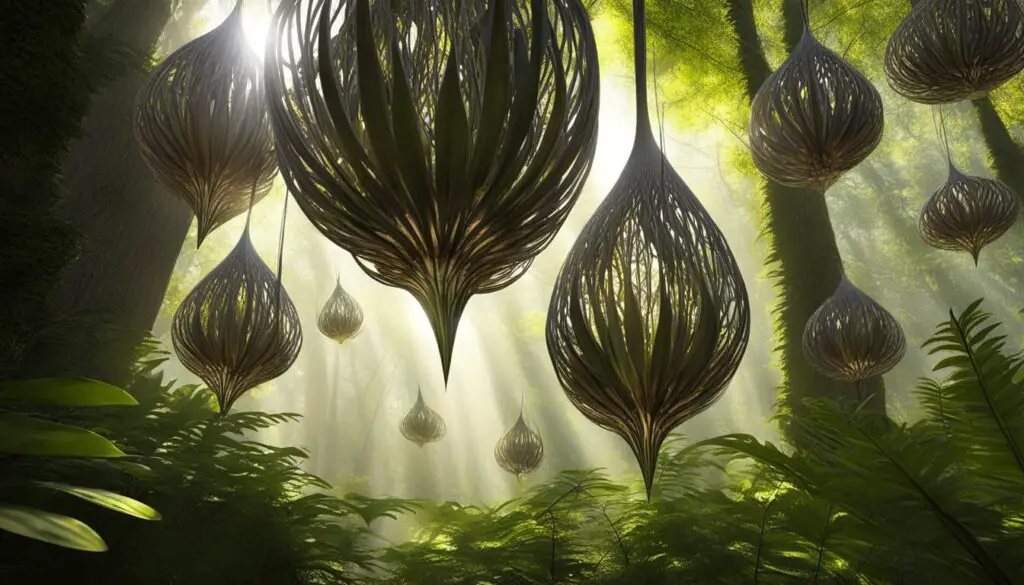
Characteristics of Large Tree Seed Pods
| Characteristics | Description |
|---|---|
| Shape | Varying shapes, such as elongated, round, or crescent-shaped pods. |
| Size | Ranges from small pods, about the size of a pea, to large pods that can be several inches long. |
| Color | Pods come in various colors, including green, brown, red, or a combination of shades. |
| Texture | Pods can have smooth, rough, bumpy, or hairy surfaces. |
By closely examining these features, botanists, horticulturists, and nature enthusiasts can identify different tree species and gain insights into their reproductive processes. Large tree seed pods are not only fascinating structures but also important indicators of tree reproduction and ecosystem health.
Identifying Large Tree Seed Pods
To accurately identify large tree seed pods, it’s essential to be familiar with their common characteristics. Paying attention to details such as texture, size, color, and shape can provide valuable clues for identification. Additionally, considering regional variations can help narrow down the possibilities and increase accuracy. Researching the native tree species in your area and their associated seed pods can be a valuable resource in the identification process.
For a more interactive and convenient experience, there are various identification tools and apps available. These resources can assist you in quickly and accurately identifying large tree seed pods based on their unique characteristics. Whether you’re a nature enthusiast, researcher, or simply curious about the world of trees, these tools can be a valuable companion on your journey of discovery.
The Process of Growing a Peach Tree from Seed
Growing a peach tree from seed can be a fulfilling and exciting endeavor. It all begins with selecting a high-quality peach seed to ensure a healthy and productive tree. Here is a step-by-step guide to help you successfully grow a peach tree from seed:
1. Peach Seed Selection
Start by choosing a ripe and fresh peach that contains a plump, undamaged seed. The seed should come from a peach variety that is well-suited to your climate and growing conditions.
2. Seed Preparation
Once you have selected the perfect seed, it’s time to prepare it for germination. Begin by cleaning the seed to remove any remaining flesh or debris. Then, allow the seed to air-dry thoroughly. To enhance germination, carefully crack the seed’s shell without damaging the kernel inside.
3. Germination Process
Peach seeds require a period of cold stratification to simulate winter conditions and promote sprouting. Place the cracked seed in a damp paper towel and seal it in a plastic bag. Refrigerate the bag for 8-12 weeks, ensuring the temperature remains between 32°F and 45°F.
After the cold stratification period, plant the seed with the cracked side down in a well-draining potting mix. Place the pot in a warm and sunny location, and keep the soil consistently moist. Within a few weeks, you should see the first signs of germination.
4. Transplanting and Tree Care
Once your peach seedling has reached a height of 6-8 inches and developed a sturdy root system, it is ready for transplanting. Choose a sunny location with well-draining soil for your peach tree. Dig a hole large enough to accommodate the root system, and gently place the seedling in the hole. Backfill with soil, ensuring the tree is upright and secure.
Provide your peach tree with regular watering, especially during dry spells. Apply a layer of mulch around the base of the tree to retain moisture and suppress weeds. Prune the tree as needed to maintain its shape and remove any damaged or diseased branches. Protect your tree from pests, such as aphids and peach borers, by implementing appropriate pest control measures.
5. Patience and Fruitful Rewards
Growing a peach tree from seed requires patience, as it takes several years for the tree to reach maturity and start producing fruits. However, the rewards are well worth the wait. As your tree matures, it will reward you with delicious, homegrown peaches that are bursting with flavor.
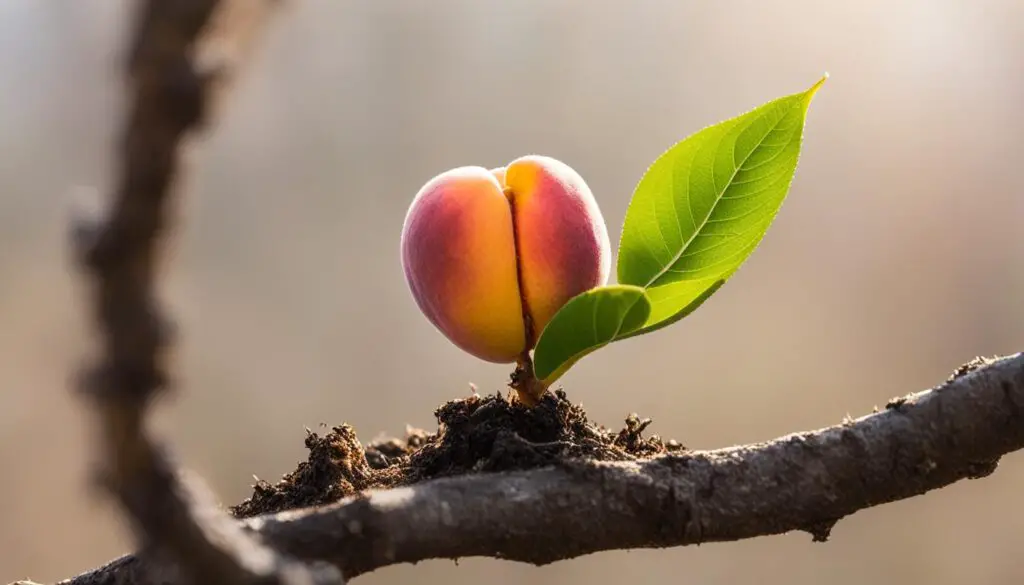
Selecting the Right Peach Seed
Growing a peach tree from seed starts with choosing the right peach seed. The quality of the seed plays a crucial role in the success of your tree’s growth. To ensure the best results, follow these guidelines when selecting a peach seed:
- Ripe and Healthy Peach: Choose a peach that is fully ripe and in good health. A ripe peach indicates that the seed inside is mature and ready to be planted.
- Plump and Undamaged: Look for a seed that is plump and undamaged. Avoid seeds that are shriveled, wrinkled, or have any signs of mold or disease.
- Freshness: Freshness is key when it comes to peach seeds. Select a seed that is fresh and hasn’t been stored for too long. Fresh seeds have a higher likelihood of germination.
Remember that the quality of your peach seed will directly impact the growth and productivity of your peach tree. Take your time to find the perfect seed that meets these criteria before moving forward with the planting process.
Tips for Selecting a Peach Seed
| Criteria | Tips |
|---|---|
| Ripe and Healthy Peach | Choose a fully ripe peach in good health. |
| Plump and Undamaged | Look for a seed that is plump and free from damage or disease. |
| Freshness | Select a fresh seed that hasn’t been stored for too long. |
Preparing the Peach Seed
Before planting the peach seed, it needs to be properly prepared to optimize germination. This involves a few essential steps, including cleaning, drying, and cracking the shell.
Cleaning the Seed
Start by cleaning the peach seed to remove any flesh and debris remaining on its surface. This can be done by gently rinsing the seed under running water, using a soft toothbrush or cloth to scrub away any stubborn residue. Ensure that the seed is thoroughly clean before proceeding to the next step.
Drying the Seed
After cleaning, allow the peach seed to air-dry completely. Place it in a well-ventilated area away from direct sunlight, and ensure there is no moisture left on the seed. This drying process helps prevent mold or rot and ensures optimal conditions for germination.
Cracking the Shell
To enhance germination, it is necessary to carefully crack the seed’s hard shell. Use a pair of pliers or a nutcracker to apply gentle pressure along the edges of the seed. The aim is to create a small opening without damaging the kernel inside. Be cautious not to exert too much force, as this may harm the seed’s viability.
Once the peach seed has been prepared through cleaning, drying, and cracking the shell, it is ready to be planted. Follow the appropriate germination process to give your peach seed the best chance of sprouting and growing into a thriving peach tree.
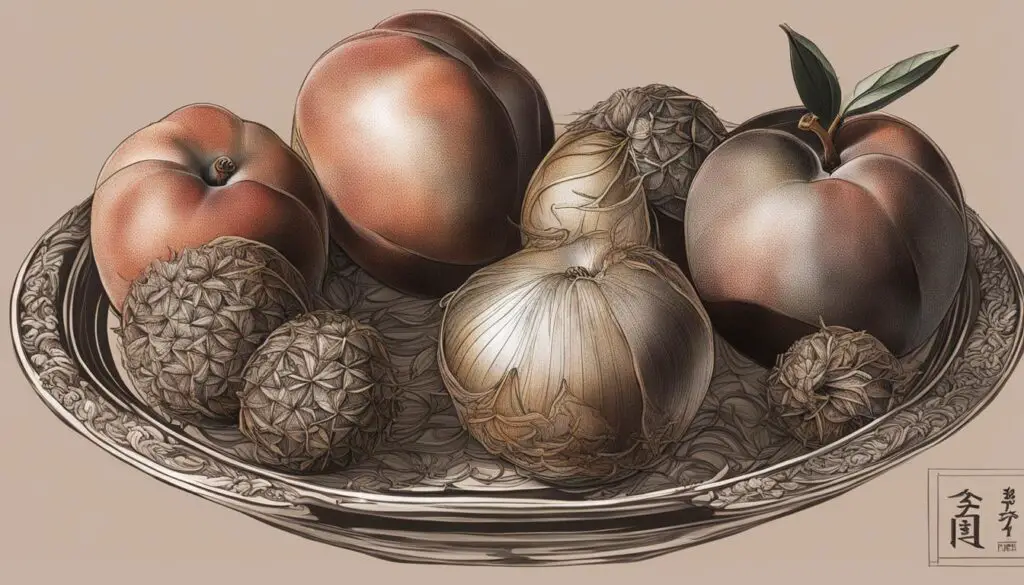
Germination Process of Peach Seeds
Growing a peach tree from seed involves a fascinating germination process that requires specific techniques to ensure successful sprouting. Understanding the key steps, such as cold stratification, planting the seed, and providing proper care, is essential for nurturing healthy peach seedlings.
Cold Stratification: Simulating Winter
Peach seeds require a period of cold stratification to break their dormancy and mimic the natural conditions they would experience during the winter months. This cold treatment prepares the seeds for germination.
To cold stratify peach seeds:
- Moisten a paper towel or sphagnum moss
- Place the seeds on the damp material
- Wrap them in plastic wrap or seal them in a ziplock bag
- Store them in the refrigerator for approximately 8-12 weeks at a temperature between 33-40°F (0.5-4°C)
This simulated winter period prompts the seeds to undergo physiological changes, breaking their dormancy and preparing them to sprout when conditions become favorable.
Planting the Seed: Setting the Stage for Growth
After the cold stratification period, it’s time to plant the peach seed. Follow these steps:
- Choose a well-draining potting mix. A combination of organic compost and sand is ideal.
- Fill a pot or container with the potting mix.
- Make a small hole in the soil, approximately one inch (2.5 cm) deep.
- Place the peach seed in the hole with the cracked side facing down.
- Cover the seed with soil and gently pat it down.
- Water the soil to ensure proper moisture.
Care: Nurturing Seedling Growth
Care plays a crucial role in the successful growth of peach seedlings. Here are some essential care tips:
- Keep the soil consistently moist, but not waterlogged. Avoid overwatering, as it can lead to rot.
- Provide ample sunlight. Place the pot in a location where the seedling can receive at least 6-8 hours of direct sunlight daily.
- Protect the seedling from extreme temperatures. Shield it from frost or heatwaves to prevent damage.
- Monitor for pests and diseases. Inspect the seedling regularly for signs of pests or diseases, such as aphids or fungal infections.
With proper care and attention, the peach seed will sprout, and the seedling will slowly grow into a healthy peach tree, ready to bear fruit in the years to come.
Transplanting and Protecting Your Peach Tree
Once your peach seedling has grown to a height of 6-8 inches and developed a robust root system, it is time to transplant it to a permanent location. Proper transplanting is vital for ensuring the tree’s long-term health and productivity.
When selecting a location for your peach tree, choose an area that receives full sunlight and has well-draining soil. Peach trees thrive in sunny environments and require at least six hours of direct sunlight each day. Additionally, well-draining soil prevents waterlogged conditions that can lead to root rot and other problems.
To transplant your peach tree, follow these steps:
- Dig a hole that is slightly wider and deeper than the root ball of your seedling.
- Gently remove the seedling from its current container, being careful not to damage the roots.
- Place the seedling in the hole, ensuring that the roots are spread out evenly.
- Backfill the hole with soil, carefully firming it around the base of the tree.
- Water the newly transplanted tree thoroughly, providing enough water to dampen the root zone.
- Apply a layer of organic mulch around the base of the tree, leaving a gap between the mulch and the trunk to prevent moisture buildup.
Once your peach tree is transplanted, it is essential to implement effective pest control measures and preventive measures against common peach tree diseases. Regular inspection of the tree for signs of pests or diseases is crucial for early intervention and successful management.
Some common pests that affect peach trees include:
- Peach tree borers
- Plum curculio
- Peach leaf curl
To control these pests, consider using natural or organic methods such as insecticidal soaps, neem oil, or beneficial insects. Additionally, practicing good sanitation, such as removing fallen leaves and fruit, can help reduce the pest population.
Peach tree diseases can be prevented through proper pruning and maintenance. Regularly inspect your tree for signs of diseases like peach leaf curl or brown rot. If detected, promptly remove and destroy the affected plant parts to prevent the spread of the disease.
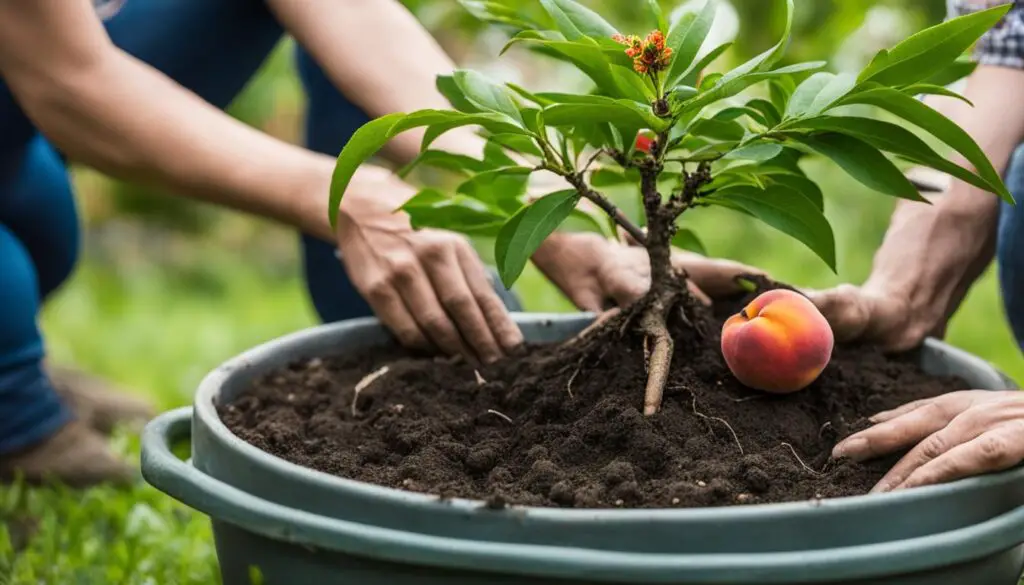
Remember, a healthy peach tree is more resilient against pests and diseases. Providing your tree with adequate water, nutrition, and regular care will help it thrive and produce delicious peaches for years to come.
Harvesting the Fruits of Your Peach Tree
Growing a peach tree from seed is a labor of patience and dedication. It takes a few years for the tree to reach maturity and produce its delicious fruits. But the wait is definitely worth it, as harvesting the peaches brings sweet rewards that embody the fulfillment of your effort.
When your peach tree is ready to bear fruit, you’ll notice several signs of maturity. The peaches will develop vibrant colors, ranging from pale yellow to deep orange, depending on the specific variety you’ve grown. They will also emit a fragrant aroma, tempting your senses with their enticing scent.
To ensure that your peaches are at their peak of ripeness, gently press the flesh near the stem. If it yields slightly, it’s a good indication that the fruit is ready to be harvested. Avoid applying excessive force, as peaches bruise easily.
When it’s time to harvest your peaches, use a sharp pair of scissors or pruning shears to cut them from the tree. Leave a small stem attached to each fruit, as this helps prolong their shelf life. Be careful not to damage the branches or neighboring fruits.
Once harvested, your peaches can be enjoyed in a variety of ways. Indulge in the simple pleasure of biting into a juicy, sun-ripened peach or use them in culinary creations such as pies, cobblers, jams, or preserves. However you choose to savor your harvest, the sweetness of freshly picked peaches will surely be a delightful reward for your dedication to growing a peach tree from seed.
| Peach Variety | Color | Aroma | Maturity | Harvest Window |
|---|---|---|---|---|
| Yellow Peach | Pale yellow to golden | Subtle, sweet fragrance | Soft when gently pressed | Mid to late summer |
| White Peach | Creamy white to blush pink | Delicate floral aroma | Firm with a slight give | Mid to late summer |
| Red Peach | Reddish-orange to deep crimson | Rich, fruity scent | Soft when pressed but not mushy | Mid to late summer |
Building a Community of Tree Enthusiasts
Connecting with fellow tree enthusiasts is a wonderful way to deepen your knowledge and share your experiences. By building a community around tree appreciation, you create a space for like-minded individuals to come together, fostering a collaborative learning environment.
Within this community, you can seek advice from seasoned tree enthusiasts who can provide valuable insights and guidance. Additionally, this platform allows you to share photographs of trees you encounter, exchanging awe-inspiring visuals with others who appreciate the beauty of nature.
“Building a community of tree enthusiasts not only enhances your understanding of trees, but also strengthens our collective appreciation for the natural world.”
One of the key benefits of this community is the opportunity to collectively work towards becoming experts in large tree seed pod identification. By sharing your observations and discoveries, you contribute to the collective knowledge base, allowing others to learn from your experiences and vice versa.
Whether it’s through online forums, social media groups, or local meet-ups, the community of tree enthusiasts offers a supportive and welcoming space where you can engage in meaningful discussions, exchange ideas, and expand your horizons.
Remember, knowledge sharing and community building are at the heart of this endeavor. Together, we can deepen our understanding of trees and continue to nurture our love for these magnificent wonders of nature.
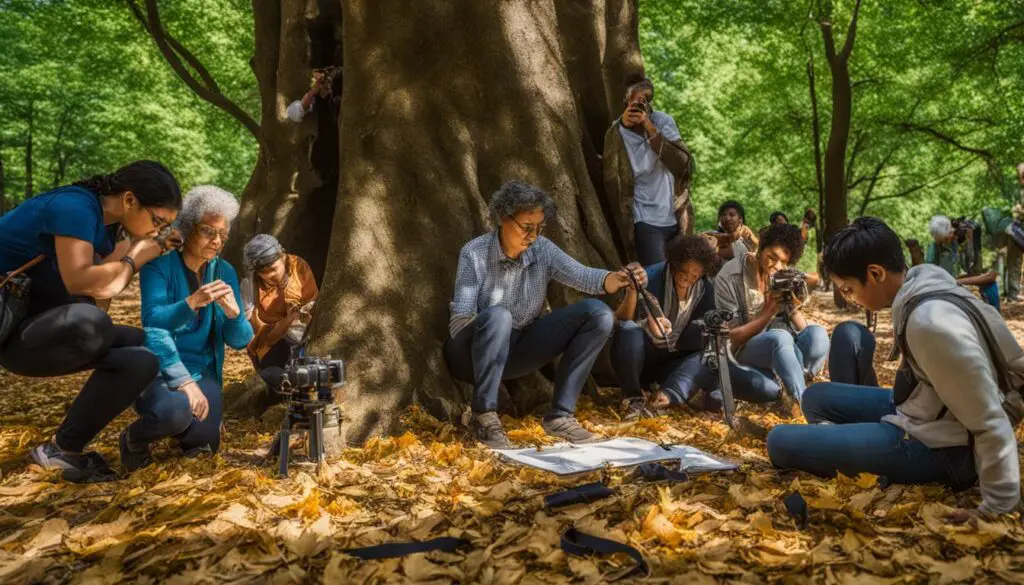
Conclusion
Understanding the secrets of tree reproduction, from mast seeding to seed dispersal, provides valuable insights into the fascinating ways trees sustain their legacy in the natural world. This knowledge deepens our appreciation for the intricate mechanisms that ensure the survival and propagation of tree species.
In addition to studying tree reproduction, there is immense joy and satisfaction in growing a peach tree from seed. This rewarding experience allows us to actively contribute to a thriving ecosystem and witness the beauty of nature firsthand. As the tree blossoms and bears fruits, we become part of a cycle that nourishes both the environment and our own souls.
Embrace the journey of discovery, whether it involves unraveling the mysteries of large tree seed pods or nurturing the growth of a peach tree. These endeavors connect us with the wonders of the natural world, reminding us of the interconnectedness of all living beings and the importance of preserving our precious ecosystems.
FAQ
How do trees reproduce?
Trees reproduce through a process called pollination, where male pollen is transferred to female reproductive parts. This can happen through wind, insects, or other animals.
What is mast seeding?
Mast seeding is a reproductive strategy where trees produce a large volume of seeds at periodic intervals. It is believed to be a defense mechanism against seed predation by animals.
How do trees disperse seeds?
Trees disperse seeds through various methods, including wind dispersal, animal dispersal (through attachment or ingestion), and water dispersal.
What are large tree seed pods?
Large tree seed pods are protective vessels that hold seeds until they are ready to disperse. They come in various shapes, sizes, colors, and textures, specific to each tree species.
How can I identify large tree seed pods?
To identify large tree seed pods, look for characteristics such as texture, size, color, and shape. Researching native tree species and using interactive identification tools can also help.
How can I grow a peach tree from seed?
Growing a peach tree from seed involves selecting a high-quality seed, cleaning and drying it, cracking the shell, cold stratification, planting in well-draining soil, and providing proper care.
How do I select the right peach seed?
Select a ripe and healthy peach, and choose a plump and undamaged seed for planting.
What should I do to prepare the peach seed?
Clean the seed to remove any remaining flesh, dry it thoroughly, and crack the shell carefully without damaging the kernel inside.
What is the germination process for peach seeds?
Peach seeds require cold stratification to simulate winter conditions. Afterward, plant the cracked seed in well-draining soil, provide consistent moisture and sunlight, and ensure proper care.
How do I transplant and protect my peach tree?
Transplant the peach seedling to a suitable location with full sunlight and well-draining soil. Implement pest control measures and prevent diseases through pruning and maintenance.
When can I harvest the fruits of my peach tree?
It takes several years for a peach tree to mature and produce fruits. Once the peaches are ripe, they can be harvested gently.
How can I build a community of tree enthusiasts?
Connect with fellow tree enthusiasts to share knowledge, experiences, and photographs. By fostering a collaborative learning environment, you can collectively become experts in large tree seed pod identification.
What are the secrets of tree reproduction?
Tree reproduction involves various processes such as mast seeding, pollination, seed dispersal, fertilization, germination, and seedling development. Understanding these processes offers insights into how trees sustain their legacy.
What is the significance of large tree seed pods?
Large tree seed pods play a crucial role in tree reproduction by serving as protective vessels for seeds until they are ready to disperse, ensuring the survival and propagation of tree species.
How does growing a peach tree from seed contribute to a thriving ecosystem?
Growing a peach tree from seed supports biodiversity by adding to the number of peach trees and creating habitats and food sources for various organisms.
Source Links
- https://phys.org/news/2023-08-trees-seeds-secrets-mast-seeding.html
- https://medium.com/@babulakhterbabul71/unlocking-the-secrets-how-to-grow-a-peach-tree-from-seed-9ecab86c4e33
- https://medium.com/@babulakhterbabul71/unlocking-the-secrets-a-comprehensive-guide-to-large-tree-seed-pod-identification-08fb7917878e

